The Kiran Nadar Museum of Art, known as KNMA, is located in an unassuming shopping mall in the DLF South Court Mall in Saket, South Delhi. Inside, at the end of a nave-like space, you encounter a towering installation by Subodh Gupta called Line of Control, a silver mushroom cloud made of empty pots and pans that refers to India-Pakistan tensions in the late 1990s and those left hungry when resources were diverted to the nuclear arms race. Nadar first saw it at Tate Britain, but the piece’s looming menace seems incongruous here, surrounded by empty shop fronts and the flags advertising beauticians, local cafes and ‘competitive warranty solutions’.
Since it opened in 2010 as the first private museum in India devoted to modern and contemporary art, KNMA has established itself as an authority in the field. A career retrospective of the Indian minimalist, Nasreen Mohamedi, was, as Nadar describes it, ‘a path-breaker’, giving the museum new international prominence. The well-received exhibition, which featured Mohamedi’s early sketches, linear drawings and later photographs, toured to the Reina Sofia in Spain, and then opened at the Met Breuer in New York last year. Nadar also supported the recent show devoted to the self-taught artist Bhupen Khakhar at Tate Modern, both financially and through the loan of several important works from her collection.
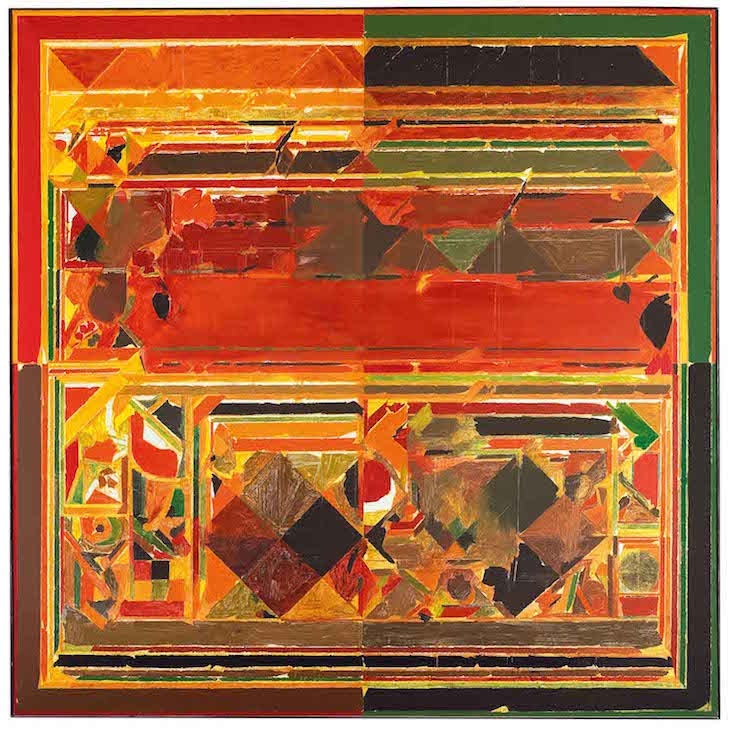
Saurashtra (1983), S.H. Raza. Kiran Nadar Museum of Art, Delhi
Kiran Nadar married her husband Shiv in January 1975, and he started his software company HCL six months later. Shiv Nadar is now one of the richest men in India – worth $12 billion according to Forbes – and the museum is an arm of his educational philanthropy, which includes an engineering college and eponymous university. In founding it, Kiran Nadar was inspired by the Guggenheim, MoMA, and the Whitney, which she notes all started out as private collections. Asked who is the biggest art collector in India at the moment, she replies with a laugh: ‘I am!’ Also an international bridge player who has represented India several times, Nadar remarks that ‘the exhilaration of acquisition’ is similar to ‘the exhilaration of winning a tournament’.
As a result, several museum directors who are over in New Delhi for the ninth edition of the India Art Fair in early February attend the opening of the exhibition ‘Stretched Terrains’ (until 31 July) at KNMA that has been designed to coincide with it. The Tate’s new director, Maria Balshaw, enjoyed an early tour, and the directors of the Guggenheim, Met and Louvre Abu Dhabi were also in attendance. A series of interrelated exhibitions, ‘Stretched Terrains’ centres around solo shows of three of the Bombay Progressives (‘The Progs’, as they referred to themselves), focusing on the early careers of F.N Souza, S.H. Raza, and M.F. Husain. Alongside architectural models, photographs and plans depicting seminal architectural buildings in Delhi, and the rush to nation-build after independence, the exhibition explores the diverse ways in which these three artists appropriated modernism.
I first encounter Nadar in her gallery, where she is waiting for her private view to begin. She is sitting next to S.H. Raza’s Saurashtra (1983), an abstract painting which on first encounter left her ‘awestruck’ and which she faced, in her description, a ‘battle royale’ to buy. ‘I was in the room [at Christie’s London in 2010], which is rare because I usually prefer to bid by phone, and there was a lady whose sole ambition was to be the owner of the most expensive work of Indian art.’ Nadar won that honour, which was cemented when she bought F.N Souza’s even more costly The Birth (1955) a few years later. ‘I’d never bid at that level before, but I’m like that: when I start bidding it’s very hard to stop.’ (The most expensive Indian painting sold at auction is now by V.S. Gaitonde, for which she was outbid: ‘I funnelled the price up,’ she says.)
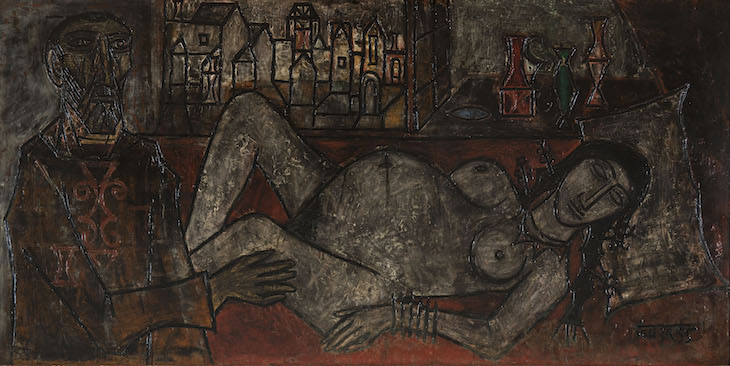
The Birth (1955), F.N. Souza. Kiran Nadar Museum of Art, Delhi
The collection began as an exercise in home decoration, with many works commissioned especially for the house that the Nadars built in a smart residential district of South Delhi. She collected, as she puts it, ‘on a whim’. The first piece she bought was of a male nude shown in front of a flayed carcass, The Runners (1982) by Rameshwar Broota, who lives and works in New Delhi. Her husband, fearing the response of his mother, who lived with them, and with concerns for their four-year-old daughter, objected. They went to visit the artist’s studio to tell him that they were withdrawing the offer, but as soon as he saw the painting Shiv Nadar was converted: ‘You’re right, we’ve got to have it,’ he said. It was then, Nadar, tells me, that she ‘realised art could move mountains’. Her husband also attended the opening of ‘Stretched Terrains’, appearing on stage next to his wife as she read a speech to the assembled guests, but he remained silent: ‘He doesn’t get involved,’ she says. ‘It’s my passion.’
Nadar soon had too many works for the walls of her house, and the idea of a museum came about because she hated the idea of them being consigned to storage. When KNMA first opened in 2010, before relocating to the shopping mall a year later, it was in a gallery created in her husband’s office outside Delhi, whose workers gave over half their cafeteria for the project. ‘Our collection wasn’t great enough,’ she recalls of the opening show. ‘Some pieces were fantastic, but some just weren’t very good – today we are much more discerning.’ Inspired by the collector Ebrahim Alkazi, she absorbed herself in art history, and with the help of KNMA’s director and chief-curator, Roobina Karode, has aspirations for her collection to be encyclopaedic. Since the museum opened, it has grown from 200 to 4,500 pieces, ranging from the late 19th century, with rare works by Raja Ravi Varma, to blue-chip names like Anish Kapoor, and emerging Indian artists.
‘The government isn’t proactive,’ Nadar says. ‘There is apathy in India as far as art is concerned, and that needs to be broken.’ Her private museum was intended to fill the void that she believed was being left by institutions such as the National Gallery of Modern Art in Delhi, which had done little to promote contemporary art. ‘We were looking for appropriate space and we couldn’t find anything,’ she says of her hunt for a location. ‘The shopping mall was appropriate. We had 18,000 sq ft of perfect space.’ She hoped its prosaic location would make it a less intimidating place for the public to visit. Nadar describes her free museum as ‘a place of confluence’; education is a key part of KNMA’s programme, with frequent ‘people-centered’, ‘action-orientated’ workshops and symposia. But Nadar admits they struggle to get people through the doors, with an average of only 100 visitors a day. ‘We thought that the mall would generate considerable footfall. Unfortunately it never quite took off.’ She hopes this will change with her dream of constructing a new, purpose-built museum in central Delhi.
Because of the frequent school tours, and the censorious nature of Narendra Modi’s conservative, Hindu nationalist government, a room dedicated to Souza’s sensuous, spiky nudes is screened off with a curtain. Remembering the controversy surrounding Husain’s religious erotica, which were banned from the India Art Summit, the first major fair of Indian art, in 2008 because of terrorist threats from right-wing Hindu groups, Nadar feared protests and government censorship. Husain, who was a close friend of his patron, faced death threats and was forced to retreat into exile in Dubai; he died in London in 2011. ‘I wanted to show Souza’s Rape, which is a marvellous painting,’ she sighs. ‘But it was such a big show, I didn’t want to take the risk.’
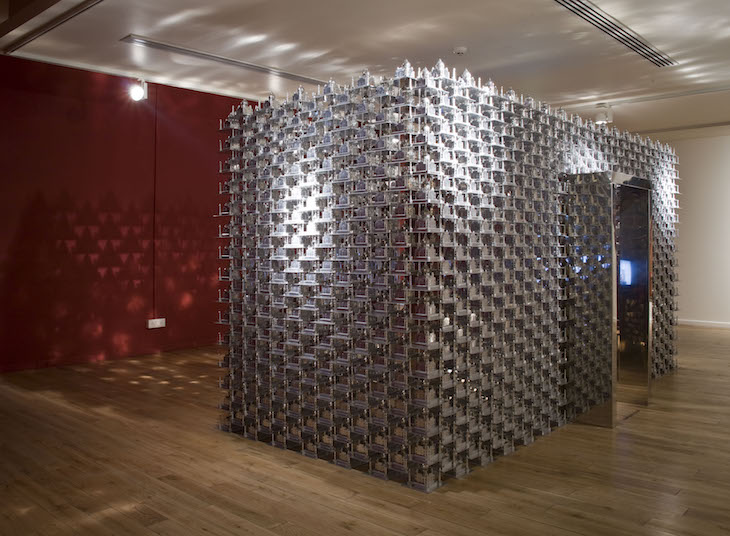
Taj Mahal (2008), Sudarshan Shetty, installation view at India Art Fair
At the current edition of India Art Fair, Nadar has bought a few small works by Naeem Mohaiemen and Prabhakar Pachpute – ‘nothing major’. She has also sponsored one of its specially commissioned projects. Sudarshan Shetty created a room whose walls are made from stacks of 250 miniature tin Taj Mahals, shown in flames in a video piece within the structure, a mausoleum of love for the tinder age. ‘Stretched Terrains’ also puts the Indian modernists alongside the contemporary, with exhibits by women artists such as Pushpamala, who has recreated a series of iconic images depicting women, such as Ravi Varma’s calendar picture of the goddess Lakshmi, her palms sprouting coins, and scenes from the film Bandit Queen.
The following day, I meet Nadar at her yearly garden party, held in collaboration with Christie’s, from whom she has acquired so many works. Her house is a sizeable compound of interrelated buildings in South Delhi, built around a huge atrium, the walls crammed with artworks especially commissioned for the space: monumental works by Raza and Husain that didn’t make it to the exhibition, and a gilded statue of a woman braiding her hair by Ravinder Reddy. The garden is decorated as if for a wedding, with hundreds of feet of white linen wrapped around palm trees, so as to form a canopy above us, and vases of flowers hanging from the branches of trees. As we talk, sitting on garden chairs on the manicured lawn, an army of staff in white jackets bring Nadar plates of food, and the last guests say their goodbyes, interrupting our conversation to shower her with gratitude and praise for the exhibition opening the night before. After another lady bows before her, paying her respects with hands clasped together as in prayer, I remark that it’s like interviewing a mafia don. She chuckles behind her Chanel sunglasses.

Photograph of M.F. Husain by Parthiv Shah, 1993. Courtesy Parthiv Shah
Between mouthfuls, Nadar tells me how she knew Raza and Husain very well, but not Souza, who lived in New York in an apartment he described as ‘fully serviced’ because it was above a diner and brothel. Husain would come to her house for social occasions, and end up climbing onto a stool so that he could retouch his canvases, muttering things like ‘the border just isn’t talking’. ‘Stretched Terrains’ includes a series of photographs of Husain ‘enacting’ his paintings, his white beard lending him the air of an old testament prophet. ‘With Husain, maybe the 1965–70 period needs more concentration,’ Nadar says, focused on filling the gaps in her collection. ‘The Raza collection also isn’t completely sewn up. His “Bindu” period is taken care of, but early Raza needs more work. But as far as Souza is concerned, I have one of the most amazing collections.’
I visit the branch of the KNMA in Noida, an hour outside Delhi and quite hard to find, a site of pilgrimage for only the most dedicated art lovers. The 13,000 sq ft gallery is on the HCL campus, in one of the site’s anonymous, air-conditioned office towers. Currently on show is Nadar’s impressive collection of video art by 15 contemporary Indian artists, including Bani Abidi, Rashid Rana, and Shakuntala Kulkarni. A uniformed security guard gives me a torch, so that I can navigate the darkened labyrinth by its feeble light, and shadows me closely on my tour. It’s an impressive assembly of artists who, as Nadar nicely put it, ‘project their talent’, and wouldn’t be out of place in any international museum.
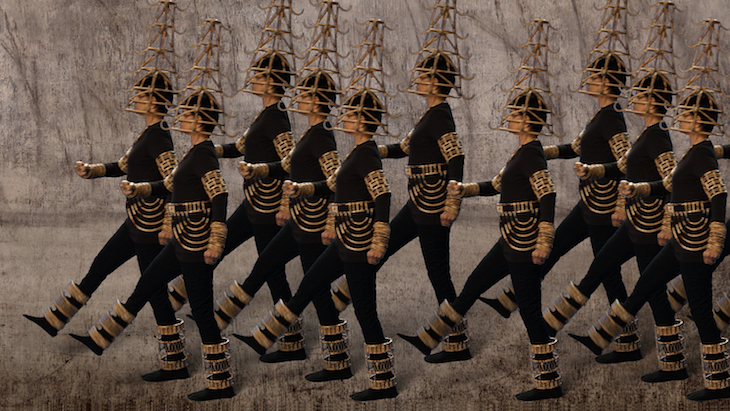
Video still from Julus (2016), Shakuntala Kulkarni. Kiran Nadar Museum of Art, Delhi
Nadar dreams of a new museum designed by a starchitect, believing no Indian is up to the task, that would bring the Bilbao effect to Delhi and create a new, museum-going culture. ‘We need to build an iconic structure somewhere,’ she says, ‘But we haven’t found the land, which is very hard to come by in central Delhi. We’ve been close a number of times, but they’ve all fallen through. But as soon as we complete, we’ll have a selection process in place.’ She’s given up hope that the government might make available to her philanthropic enterprise the use of a public plot. Nevertheless, Nadar has the deep pockets and political connections to buy one privately. I ask her when this vision might be realised, and she replies with steely determination: ‘My husband has given his team six months to find something.’
From the March 2017 issue of Apollo: preview and subscribe here
Unlimited access from just $16 every 3 months
Subscribe to get unlimited and exclusive access to the top art stories, interviews and exhibition reviews.


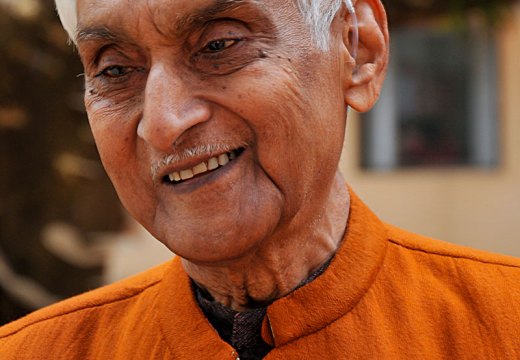
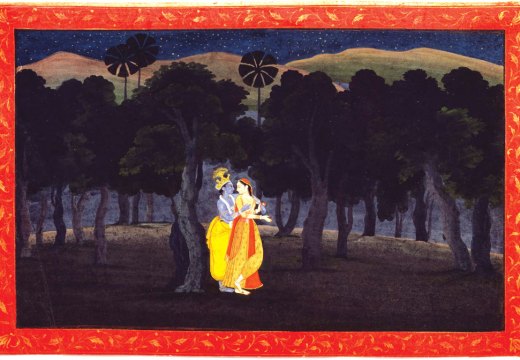
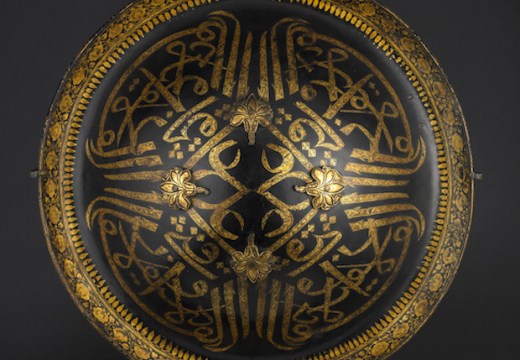









![Masterpiece [Re]discovery 2022. Photo: Ben Fisher Photography, courtesy of Masterpiece London](http://www.apollo-magazine.com/wp-content/uploads/2022/07/MPL2022_4263.jpg)
It’s time for the government of London to return to its rightful home